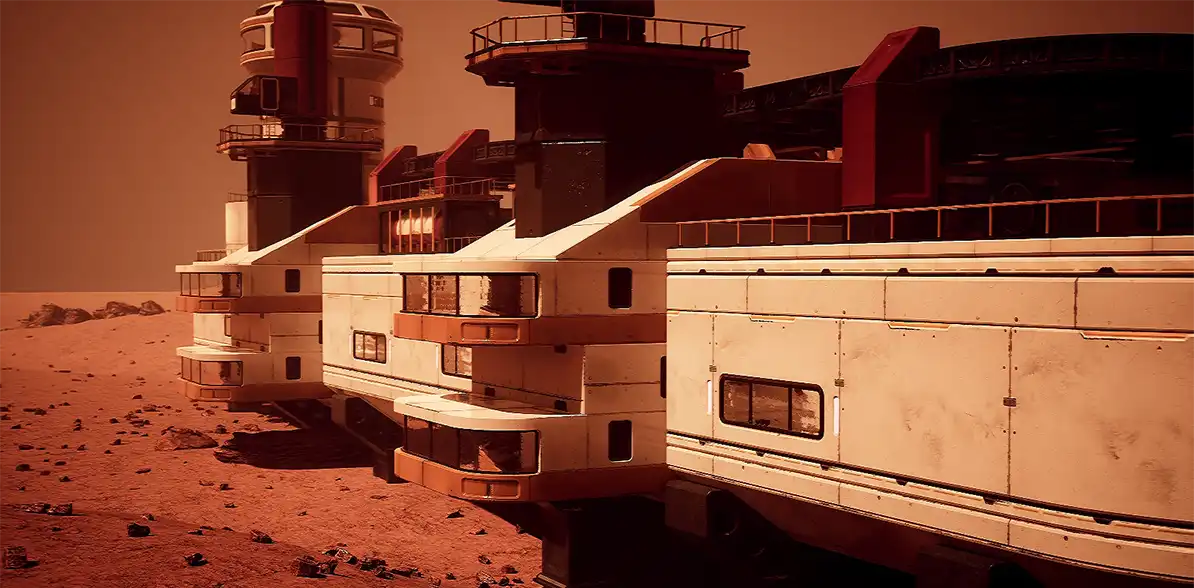This tour of Mars combines cutting-edge CGI and high-resolution imagery from real spacecraft to take you on a starfaring tour of Mars in 360° VR. Here, we’ll give you even more fascinating information about the history of the planet and our relationship with it. Check out the video and read on below to learn more!
The History of Mars
While investigations into potential signs of microbial life continue, it seems pretty likely that Mars is currently uninhabited by anything more complex than bacteria. However, the scientific community is still working to determine whether the planet was once more habitable than it was today, and if so, whether it truly played host to living organisms.
Life on Mars
The hunt for life on Mars is not just a matter of satisfying curiosity about our neighbourhood. Mars’ similarity to early Earth, preserved by the planet’s cold climate and lack of tectonic activity, means that it may be a highly useful source of information about the conditions that lead to the origin of life, even if the planet has never actually had living inhabitants.
Water on Mars
We know for a fact that Mars once had liquid water on the surface, and recent surveys by NASA’s Mars Curiosity Rover discovered evidence of nitrogen, sulphur, hydrogen, oxygen, phosphorous and carbon, all crucial chemical ingredients for organic life as we know it.
Mars' atmosphere
So why is Mars so inhospitable now? Well, the planet Earth has a magnetic field surrounding it which protects it from harmful solar radiation and keeps the planet’s atmosphere contained. For reasons we don’t yet fully understand, Mars doesn’t have a similar magnetosphere, meaning that over billions of years, what atmosphere it had was slowly stripped away and the soil on the surface is now highly irradiated.

How old is the planet Mars?
Our current best understanding suggests that Mars has been a part of our solar system since its formation, 4.6 billion years ago. What is less certain are the ages of the planet’s two moons. As we discussed in the video, Phobos and Deimos are both tiny compared to many other astronomical bodies, and they share many characteristics with asteroids, suggesting that they may have once been asteroids captured from the edge of the Asteroid Belt that spans much of the gap between Mars and Jupiter.
However, Phobos’ low density and porous nature don’t match up with our best understanding of how asteroids form. An alternative theory suggests it may be comprised of many smaller particles which coalesced in orbit from other rocks and dust particles, long after Mars itself formed.
Colonising Mars

Putting a human being on Mars would be a huge achievement for humanity. As a first step towards humankind being a spacefaring race, Mars is an obvious choice due to its proximity and its Earthlike qualities. Consequently, there have been many proposals over the decades for a human mission, ranging in scale from a scientific research visit to creating a permanent colony and terraforming the planet to be more habitable.
The benefits of colonising Mars
Aside from pure curiosity, Mars offers potentially valuable economic resources, an easier launch location for further space missions and opportunities for more detailed research far beyond what an unmanned rover can accomplish.
What’s more, an increasing number of influential thinkers believe that settling on other planets is a natural and even essential step in human development, minimising the risk of our species going extinct due to a planetary-scale disaster.
Colonising Mars will be a challenge
In addition to the thin atmosphere, highly variable temperatures, irradiated surface and lack of a magnetosphere, the low gravity, lack of water and likely isolation that would come from being so far from Earth all make Mars a hostile location.
Ultimately, though, the biggest barrier at present is money. It’s estimated the cost of sending even one person to Mars would be somewhere in the region of $500 billion, with many critics arguing such an amount could better benefit humanity if spent on more immediate improvements to our existing home.
Should we colonise Mars?

There are some who argue that colonising Mars at all is a problematic venture. Many of the biggest forces pushing for Martian colonisation are unashamedly motivated by economic growth, and the living and working conditions expected of colonists in many proposals have been decried as inhumane and akin to life under an oppressive fascist regime by human rights authorities. Looking at you, Elon.
What’s more, there are unanswered questions about the legal status of extraplanetary territories and settlements. What if we discover that Mars actually hosts life forms under the surface, whose very existence would be threatened by human terraforming efforts? Who has the legal right to the resources which can be found there? These ethical questions inevitably evoke comparisons to past efforts at colonisation, whose dark legacy still impacts our world today.
Questions like this have no easy answer, but one thing is certain: just as the first Space Race in the 1950s and ‘60s had impacts on many more things than our scientific understanding of the Moon, so too will the race to Mars reveal as much about humanity as it does about our potential future home.
Thanks for reading, and subscribe to our YouTube channel for more fantastic visual explorations of our solar system in 360° VR in future. If you're interested in a space launch of your own, get in touch.
.png)